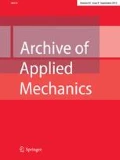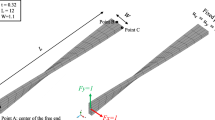Abstract
A finite element (FE) approach is presented for the dynamic analysis of the Mindlin plates considering both shear deformation and rotary inertia effects. The model is based on the consistent version of the Mindlin equations, which neglects the higher-order time derivative contribution. The approach provides a new class of interdependent Hermite shape polynomials by the definition of a fictitious deflection that takes into account the effective interdependence between the generalized displacements in both the continuous and FE discretized schemes. This implies that the proposed approach is free-shear-locking and is characterized by a good accuracy even for low-order FEs. Several examples are considered whose results are compared with analogous ones proposed in the literature with other approaches.
Similar content being viewed by others
References
Reddy J.N.: A penalty plate bending element for the analysis of laminated anisotropic composite plates. Int. J. Numer. Methods Eng. 15, 1187–1206 (1980)
Averill R.C., Reddy J.N.: On the behavior of plate elements based on the first-order shear deformation theory. Eng. Comput. 7, 57–74 (1990)
Zienkiewicz O.C., Taylor R.L., To J.M.: Reduced integration technique in general analysis of plates and shells. Int. J. Numer. Methods Eng. 3, 275–290 (1971)
Hughes T.J.R., Taylor R.L., Kanoknukulchai W.: Simple and efficient element for plate bending. Int. J. Numer. Methods Eng. 11, 1529–1543 (1977)
Reddy J.N.: An Introduction to the Finite Element Method, 2nd edn. McGraw-Hill, New York (1993)
Lee S.W., Wong C.: Mixed formulation finite elements for Mindlin theory plate bending. Int. J. Numer. Methods Eng. 18, 1297–1311 (1982)
Auricchio F., Taylor R.L.: A triangular thick plate finite element with an exact thin limit. Finite Elem. Anal. Des. 19, 57–68 (1995)
Lovadina C.: Analysis of a mixed finite element method for the Reissner–Mindlin plate problems. Comput. Methods Appl. Mech. Eng. 163, 71–85 (1998)
Hughes T.J.R., Tezduyar T.: Finite elements based upon Mindlin plate theory with particular reference to the four-node isoparametric element. J. Appl. Mech. 48, 587–596 (1981)
Bathe K.J.: Finite Element Procedures. Prentice-Hall/MIT, Englewood Cliffs (1996)
Zienkiewicz O.C., Taylor R.L.: The Finite Element Method, 5th edn. Butterworth-Heinemann, Oxford (2000)
Bletzinger K., Bischoff M., Ramm E.: A unified approach for shear-locking-free triangular and rectangular shell finite elements. Comput. Struct. 75, 321–334 (2000)
Nguyen-Xuan H., Liu G.R., Thai-Hoang C., Nguyen-Thoi T.: An edge-based smoothed finite element method (ES-FEM) with stabilized discrete shear gap technique for analysis of Reissner–Mindlin plates. Comput. Methods Appl. Mech. Eng. 199, 471–489 (2010)
Liu G.R., Nguyen-Thoi T., Lam Y.K.: An edge-based smoothed finite element method (ES-FEM) for static, free and forced vibration analyses of solids. J. Sound Vib. 320, 1100–1130 (2009)
Falsone G., Settineri D.: A Kirchhoff-like solution for the Mindlin plate model: a new finite element approach. Mech. Res. Commun. 40, 1–10 (2012)
Falsone G., Settineri D.: An Euler–Bernoulli-like finite element method for Timoshenko beams. Mech. Res. Commun. 38, 12–16 (2011)
Stephen N.G.: The second frequency spectrum of Timoshenko beams. J. Sound Vib. 80, 578–582 (1982)
Stephen N.G.: The second spectrum of Timoshenko beam theory—further assessment. J. Sound Vib. 292, 372–389 (2006)
Stephen N.G.: Mindlin plate theory: best shear coefficient and higher spectra validity. J. Sound Vib. 202, 539–553 (1997)
Levinson M.: Free vibrations of a simply supported, rectangular plate: an exact elasticity solution. J. Sound Vib. 98, 289–298 (1998)
Elishakoff, I.: An equation both more consistent and simpler than the Bresse–Timoshenko equation. In: Gilat, R., Banks-Sills, L. (eds.) Advances in Mathematical Modeling and Experimental Methods for Materials and Structures, Solid Mechanics and Its Applications. Springer, Berlin, pp. 249–254 (2010)
Nesterenko V.V.: A theory for transverse vibrations of a Timoshenko beam. PMM-J. Appl. Math. Mech. 57, 669–677 (1993)
Timoshenko S.P.: On the correction for shear of the differential equation for transverse vibration of prismatic bars. Philos. Mag. Ser. 6(41), 744–746 (1921)
Elishakoff, I.: Generalization of the Bolotin’s dynamic edge effect method for vibration analysis of Mindlin plates. In: Cuschieri, J.M., Glegg, S.A.L., Yeager, D.M. (eds.) National Conference on Noise Control Engineering. New York, pp. 911–916 (1994)
Kaplunov J.D., Kossovich L.Y., Nolde E.V.: Dynamics of Thin Walled Elastic Bodies. Academic Press, San Diego (1998)
Reddy J.N.: On locking free shear deformable beam elements. Comput. Methods Appl. Mech. Eng. 149, 113–132 (1997)
Averill R.C., Reddy J.N.: An assessment of four-noded plate finite element based on a generalized third-order theory. Int. J. Numer. Methods Eng. 33, 1553–1572 (1992)
Hashemi S.H., Arsanjani M.: Exact characteristic equations for some of classical boundary conditions of vibrating moderately thick rectangular plates. Int. J. Solids Struct. 42, 819–853 (2005)
Roberts D.B.: Formulas for Natural Frequency and Mode Shape. Van Nostrand Reinhold, New York (1979)
Author information
Authors and Affiliations
Corresponding author
Rights and permissions
About this article
Cite this article
Falsone, G., Settineri, D. & Elishakoff, I. A new locking-free finite element method based on more consistent version of Mindlin plate equation. Arch Appl Mech 84, 967–983 (2014). https://doi.org/10.1007/s00419-014-0842-1
Received:
Accepted:
Published:
Issue Date:
DOI: https://doi.org/10.1007/s00419-014-0842-1




